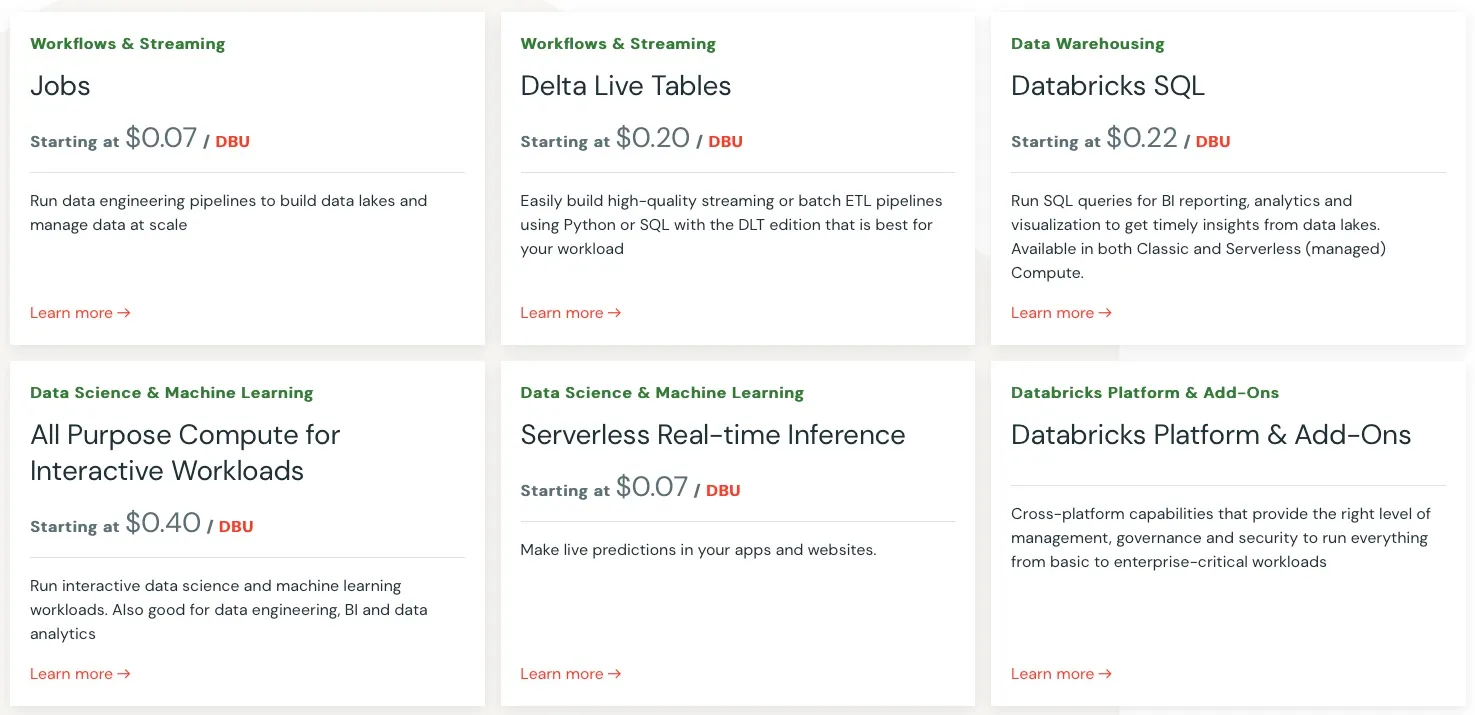



Take a self-guided tour of the platform.
See why Vertice is trusted by top procurement leaders.



Cluster management platform Databricks offers data scientists and developers a powerful unified platform for analytics, data and AI project collaboration. In its last round of funding, the vendor successfully raised $500 million and achieved a market value of $43 billion – in part thanks to its impressive client list, including household names such as AT&T and HSBC, as well as software giants Adobe and Atlassian.Evidently, the platform is trusted by the best of the best. But is it worthy of your SaaS stack?As with any purchase, cost will likely be a key consideration.Don't just take the advertised Databricks price points as gospel though. Software prices in general are very rarely set in stone and there is almost always an opportunity to secure a discount.The question is, how much of a discount could you be looking to secure?Here’s everything worth knowing.,

,
How much does Databricks cost?
Databricks offers some insight into its pricing structure on its pricing page, listing the upfront cost of several products per Databricks Unit (DBU).But what exactly does this mean?In short, a DBU is a standard unit of processing power used to measure consumption on the Databricks platform. It’s billed according to per-second usage. Additional costs for storage, networking and more will vary depending on your cloud service provider of choice, such as AWS, Azure or Google Cloud.Ultimately, how much Databricks will cost you depends on the DBUs you use across multiple services, your cloud service provider, and whether you opt for pay-as-you-go or committed-usage billing.
Databricks pricing plans
Databricks offers an initial 14-day free trial which provides access to a collaborative environment for data teams and interactive notebooks. The trial supports Apache Spark, Python, and SQL among other tools.Once the trial period is up, users will be automatically subscribed to one of two types of Databricks pricing plan. These are your options:Pay as you goDatabricks charges users based on their service usage across several core products. These are outlined below.,

, Usage is charged on a per-second basis and billed monthly by default. Or, you can contact the Databricks sales team for further billing options, such as billing by invoice or annual plan.Committed-useAlternatively, Databricks offers users the chance to save on their subscriptions by committing to certain thresholds of usage. The larger the commitment made, the greater the discount that can be achieved, as opposed to a pay-as-you-go plan.However, prospective customers will need to contact the Databricks sales team for full pricing information.So, let’s review what we know. There are standard list prices for usage across several Databricks products — but what will your material cost come to?The problem is, the pricing information publicly available doesn’t shed any light on what you’ll actually end up paying, or the kind of discount you should expect.As a prospective customer, you’re on the back foot — how will you know whether a Databricks subscription is within your budget? And if you do approach the sales team for a quote, how will you know whether the fee you’re offered is a good deal?This is part of the pricing transparency issue in SaaS purchasing.So, to gain some deeper insights, you have a couple of options that don’t involve approaching the vendor straight away.Firstly, you could search online for anecdotal information about what other companies pay for their Databricks subscriptions.We ran a quick search and found this PeerSpot thread asking subscribing organizations what they pay.After a sift through the comments, we found one user claiming that their yearly costs fall somewhere between $25,000 and $30,000.,

, In contrast, another commenter from Infosys writes that in their experience, the cost sits at $600,000 for 50 users.,

, Clearly, there’s more than a little variance between what companies of different profiles pay per year — but even with a ballpark figure for the kind of cost you can expect, you don’t gain much insight by way of the Databricks services or DBUs that each user was purchasing.And they also don’t tell you what kind of volume discount the users received.So, is there another option?Yes — you can talk to Vertice. We have access to pricing and discounting data from over 16,000 global SaaS vendors, so you can see what companies with similar usage needs to your own are paying. But we’ll come onto that shortly., , , ,
How much of a discount could you be looking to secure on Databricks pricing?
Databricks clearly outlines that volume-based pricing is available, and according to our data, prospective customers are highly likely to secure a discount. This is unsurprising — after all, list prices are rarely set in stone. In fact, the average discount offered by data warehousing vendors is 19% off of the listed price.What’s even more promising, however, is that Databricks has a relatively low pricing parity score of 59/100. This indicates that customers with similar usage profiles are paying substantially different rates for comparable contracts.So, just how much of a discount could you secure on Databricks costs?That will all come down to your software negotiation strategy. Here are some useful tactics to consider.
Commit to a longer subscription period
One method that could secure a reduced Databricks cost is signing up for a longer subscription term. The vendor’s pricing page stipulates that although monthly billing is the default, there is an option to be charged on a yearly basis instead.Negotiating with Databricks regarding a yearly or even a multi-year subscription could yield extra savings. Our data shows that in general, vendors tend to offer a discount average of 5% from the asking price for each extra year that a subscriber commits to. So, if you know that your organization’s data and analytics needs will extend into the foreseeable future, negotiating a longer term could save you money in the long run.
Research competitor comparisons
Another common strategy is to seek insights and quotes on pricing from competitor vendors. In this case, providers like Snowflake offer similar data warehousing services to Databricks. The terms offered by Snowflake could be leveraged to secure a matched or beaten deal from the Databricks sales team.However, it’s not just the monthly fees that can be negotiated. To position yourself to secure a deal tailored to your business requirements, you may also negotiate with terms such as:
- Price uplift clauses
- Customization options
- Maintenance and support
Use a negotiation mediator
While negotiating software contracts can be a fruitful spend management measure, it’s a significant drain on your time and resources to research, strategize and negotiate best-in-class contracts. Thankfully, there is another solution.Partnering with a third-party mediator like Vertice to negotiate on your behalf can free up your team’s time for more strategic priorities. This is known as shuttle diplomacy — a popular SaaS purchasing solution that allows companies to relay queries and proposals to their chosen vendor without directly contacting them. This creates a sense of impartiality that can lead to more successful negotiations.,
Leverage pricing benchmarks with Vertice
As we’ve discussed, the best type of leverage is pricing benchmark data from companies with similar needs to your own. This is where we come in.With access to transactional data from over 16,000 worldwide vendors, Databricks included, our professional SaaS buyers are equipped with the necessary intel to secure you the best possible deal. We’ll handle negotiations from start to finish, saving you the time and energy spent purchasing and renewing software — and ensuring you get the best possible price.See for yourself how much you could be saving on your annual software spend, or alternatively browse our database for more exclusive vendor pricing insights.,

, , , , , , , , , , , , , , , , , , , , , , , , , , , , , , , , ,
.webp)















